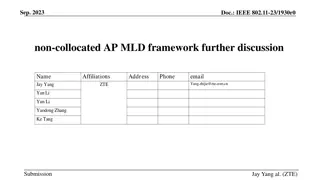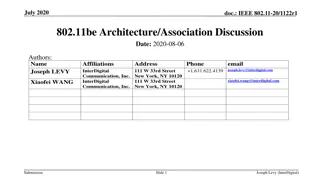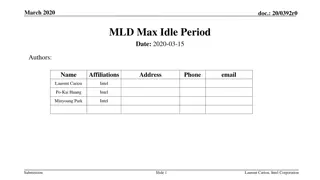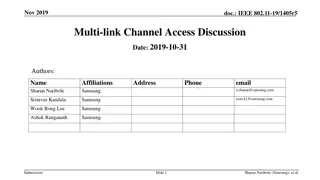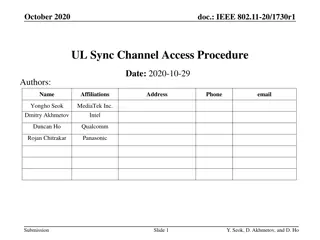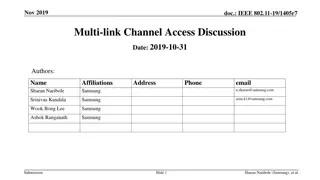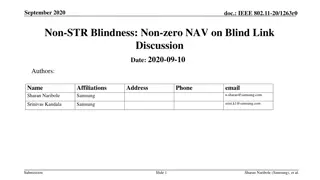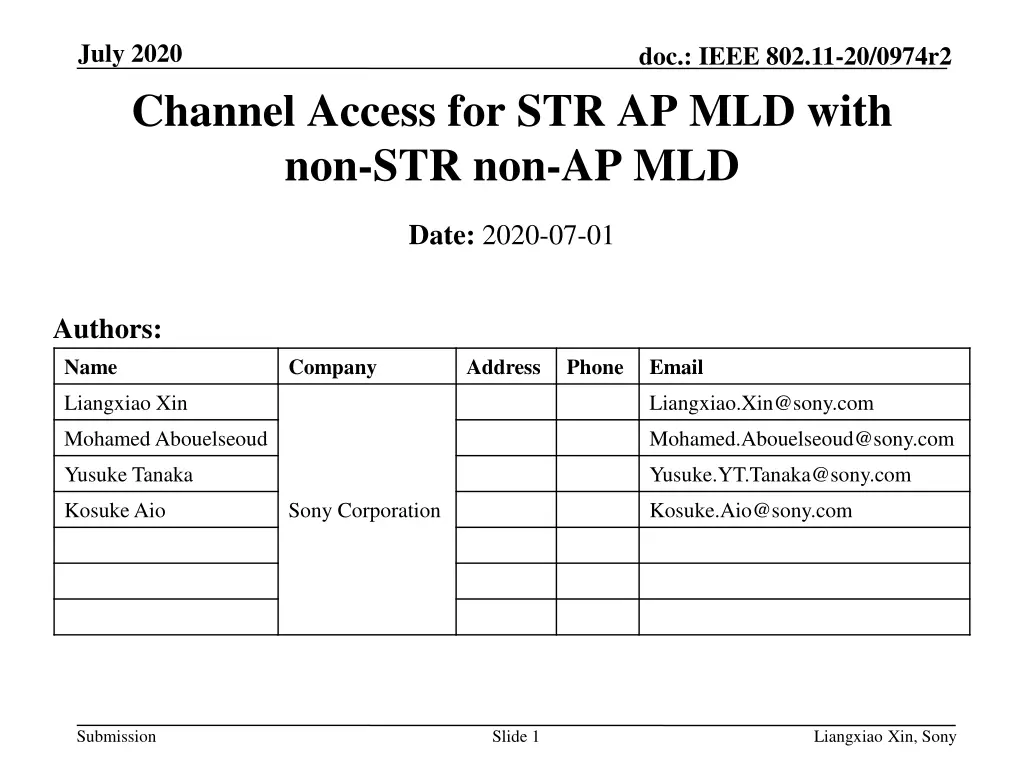
Channel Access for Multi-Link Devices in IEEE Networks
Explore the challenges of channel access for multi-link devices in IEEE networks, discussing fairness issues and proposing solutions for efficient transmission management. Join the conversation on optimizing channel reservation and enhancing non-STR non-AP MLD access for improved network performance.
Download Presentation

Please find below an Image/Link to download the presentation.
The content on the website is provided AS IS for your information and personal use only. It may not be sold, licensed, or shared on other websites without obtaining consent from the author. If you encounter any issues during the download, it is possible that the publisher has removed the file from their server.
You are allowed to download the files provided on this website for personal or commercial use, subject to the condition that they are used lawfully. All files are the property of their respective owners.
The content on the website is provided AS IS for your information and personal use only. It may not be sold, licensed, or shared on other websites without obtaining consent from the author.
E N D
Presentation Transcript
July 2020 doc.: IEEE 802.11-20/0974r2 Channel Access for STR AP MLD with non-STR non-AP MLD Date: 2020-07-01 Authors: Name Company Address Phone Email Liangxiao Xin Liangxiao.Xin@sony.com Mohamed Abouelseoud Mohamed.Abouelseoud@sony.com Yusuke Tanaka Yusuke.YT.Tanaka@sony.com Kosuke Aio Sony Corporation Kosuke.Aio@sony.com Submission Slide 1 Liangxiao Xin, Sony
July 2020 doc.: IEEE 802.11-20/0974r2 Introduction STR AP MLD and non-STR non-AP MLD are expected to be supported in R1[1] For STR AP MLD and non-STR non-AP MLD: Non-STR MLD is not able to receive on one link while transmitting on another link simultaneously due to the in-device coexistence interference It is not decided yet how STR AP MLD contends the channel and reserves the TXOP on multiple links [2-9] There are fairness issues regarding channel access among STR AP MLD and non-STR non-AP MLD that is needed to be discussed. In this presentation, we discuss channel access and reservation for STR AP MLD and non-STR non-AP MLD Submission Slide 2 Liangxiao Xin, Sony
July 2020 doc.: IEEE 802.11-20/0974r2 Motivation Problem 1: How to launch transmission on multi-link? Synchronized channel access on multiple links is attractive and easily can enable PPDU alignment but difficult to achieve. Asynchronized channel access on multiple links is more practical but needs extra work to enable PPDU alignment Problem 2: How to end transmission on multi-link? There is no restriction on TXOP reservation on multiple links When STR AP MLD and non-STR non-AP MLD coexists, channel access fairness issues can prevent non-STR non-AP MLD from accessing the channel We propose to enable flexible channel access and TXOP reservation restriction in cases of STR AP MLD and non-STR non-AP MLD STR AP MLD is flexible to start transmitting on multiple links at the same/different time depending on the channel condition When accessing a new link, STR AP MLD should limit its TXOP reservation on the new link such that it does not exceed any active TXOPs on other links Submission Slide 3 Liangxiao Xin, Sony
July 2020 doc.: IEEE 802.11-20/0974r2 Problem1: Fairness issue discussion Non-STR MLD can t gain channel access on multi-link when STR MLD always occupies at least one link. (as shown in the figure) STR AP MLD has higher chance to gain channel access on one link when it occupies another link (Non-STR MLD are not competing) STR AP MLD will have an advantage of reserving consecutive overlapping TXOPs on multiple links and blocking other non-STR MLD STAs from accessing the channel Non-STR non-AP MLD should have fair chance to access the channel Submission Slide 4 Liangxiao Xin, Sony
July 2020 doc.: IEEE 802.11-20/0974r2 Proposed solution We propose to add restriction on the STR AP MLD reserving TXOPs with non-STR non-AP MLD. When accessing a new link, STR AP MLD should limit its TXOP reservation on the new link such that it does not exceed any active TXOPs on other links Example: TXOP2 and TXOP3 do not exceed TXOP1. When TXOP1 and TXOP3 end at the same time, non-STR non-AP MLD can immediately contend over both links. Submission Slide 5 Liangxiao Xin, Sony
July 2020 doc.: IEEE 802.11-20/0974r2 Problem 2: Multi-link channel Access JMPC has been discussed for synchronized channel access [9] Contend for medium, access to the medium on another link by doing ED for PIFS time Has regulatory restriction, chances to join medium are not high and has fairness issues We propose using same random backoff number initialization for the ML channel access AP MLD sets the random backoff counters of an AC in multiple links to one value using the same random number generator The count down on each link is running at the same time independently The EDCA backoff countdown procedure on each link is independent Submission Slide 6 Liangxiao Xin, Sony
July 2020 doc.: IEEE 802.11-20/0974r2 Examples of proposed solution Example 1: When the two links are idle (no CCA busy), the backoff on Link 1 and 2 count down to zero at the same time Example 2: When Link 2 experience CCA busy during count down, the backoff on Link 1 and 2 count down to zero at the different times Example 3: If Link 2 failed to access the channel till the end of the active TXOP on link 1, the backoff timer of Link 2 may be reset ( to avoid fairness issues and make synchronized access easier) Submission Slide 7 Liangxiao Xin, Sony
July 2020 doc.: IEEE 802.11-20/0974r2 Benefits of same random backoff number The same random backoff number initialization enables the AP MLD to have easier channel access on multiple links depending on the channel condition STR AP MLD has higher chance to gain access on multiple links at the same time when the channels are less busy STR AP MLD is also allowed to gain access on multiple links at different times depending on channel conditions The same random backoff number initialization does not violate any EDCA rule. There should be no fairness issues between the AP MLD and other devices (including legacy devices) accessing these links There might be few updates needed to the current EDCA mechanism How to setup the contention window is TBD CW update could be the same as in the current standard The same random backoff number initialization may be used when CWs of an AC on multiple links are the same. Submission Slide 8 Liangxiao Xin, Sony
July 2020 doc.: IEEE 802.11-20/0974r2 Summary In this presentation, in order to enable fair and dynamic channel access for an STR AP MLD that communicates with a non-STR non-AP MLD, we propose: STR AP MLD should limit its TXOP reservation on a new link such that it does not exceed any active TXOPs on other links STR AP MLD uses the same backoff number to contend the channel access on multiple links and independently count down on each link Submission Slide 9 Liangxiao Xin, Sony
July 2020 doc.: IEEE 802.11-20/0974r2 SP1 Do you agree to add the following to 11be R1 SFD: 11be defines a mechanism to solve the following fairness issue in case of channel access between STR MLD and NSTR MLD Fairness issue: the NSTR non-AP MLD does not gain channel access on any link of one of its NSTR link pairs for a long time because the STR AP MLD always occupies at least one link of the NSTR link pair to transmit DL QoS Data frames to the NSTR MLD The solution is TBD Submission Slide 10 Liangxiao Xin, Sony
July 2020 doc.: IEEE 802.11-20/0974r2 SP2 Do you support to include the following in SFD? An STR AP MLD communicating with non-STR non-AP MLD may initialize the random back-off counter of an AC in multiple links to one value using the same random number generator. The count down on those links is independent and depends on the channel condition Submission Slide 11 Liangxiao Xin, Sony
July 2020 doc.: IEEE 802.11-20/0974r2 References [1] 11-20/0566r20: Compendium of straw polls and potential changes to the Specification Framework Document [2] 11-20/0275r2: MLO: Need for sync PPDUs [3] 11-19/1305r4: Synchronous Multi-Link Operation [4] 11-20/0106r4: Follow up of discussion on multi-link operation with leakage on non-AP MLD [5] 11-20/0026r6: MLO: Sync PPDUs [6] 11-20/0291r1: MLO asynchronize and synchronize operation discussions [7] 11-20/0433r5: PPDU alignment in STR constrained multi-link [8] 11-20/0081r2: MLO Synchronous Transmission [9] 11-20/0455r2: Asynchronous multi-link operation for non-STR STA Submission Slide 12 Liangxiao Xin, Sony


